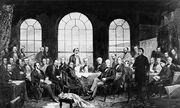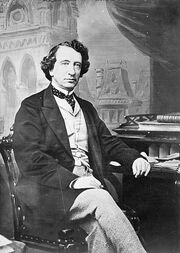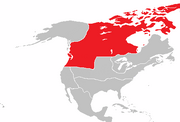| |||||
| Anthem | "O Canada" | ||||
| Capital | Winnipeg | ||||
| Largest city | Calgary | ||||
| Other cities | Edmonton, Seattle | ||||
| Language | English | ||||
| Religion main |
Protestantism | ||||
| others | Roman Catholicism | ||||
| Demonym | Canadian | ||||
| Currency | Pound | ||||
History[]
Loss of Quebec[]
Expansion[]
Following the disastrous defeat in the War of 1812, a huge number of Loyalist settlers were displaced, with many moving to west of Quebec. The small town of Winnipeg soon grew, with populations reaching the thousands. New settlers moved in to settle in the farmlands around the Red and Assiniboine rivers. The rich fur trade brought settlers to the lowly-populated Oregon territory, with a number of trappers, farmers, and missionaries arriving in the 1810s-1840s. Before America could claim the territory, the British proclaimed the land now belonged to the colony of Oregon in 1830. Oregon City was declared the capital, and was later moved to Salem in 1851. The British, fearing Quebec and American expansion, quickly propped up the colonies in Canada and Oregon, and helped fund the buildings of new railroads, mines, canals, and factories. Meanwhile, many immigrants from Britain, Ireland, and Europe increased the population, and in 1840 responsible government was declared in Canada.
Tensions grew between Canada and Quebec and America, as all three nations argued over territory. America, in particular, was governed by the Nationalist Party, which believed in expansion and hedgemony over the continent. The American victory in the Mexican War and arguments over the boundaries of Oregon confirmed the fear of expansion, and, as a first step toward colonial unity, a full-time Canadian Army was founded. In 1858, the Confederate War of Independence broke out, and in 1860, Britain declared their support of the Confederacy. Canadians felt it was time to gain vengeance, and in the summer of 1860 the Canadian Army invaded Quebec and cut off the resource rich regions of northern Quebec to the factory-filled cities out the south. With British reinforcements arriving, Quebec, along with America, had no choice but to sue for peace.
Confederation[]

Fathers of Confederation
Following the war, several constitutional conferences, a confederation was created, beginning the Dominion of Canada. Initially made up of the 3 provinces of Keewatin, Manitoba, and Sasketwachan, the Dominion later expanded into Alberta, British Columbia, Oregon, and the Northwest Territories. John A. MacDonald became Prime Minister and presided over a magnificent era of Canada. Thousands of immigrants poured into Canada, eager to settle the fertile lands of Oregon and Manitoba. By the end of the War of 1885, Canada would rival the Confederate States in being

The first Prime Minister of Canada, John A. MacDonald
the greatest source of crops in North America, with an abundance of wheat. Meanwhile, the resources collected from the rich areas of western Canada entered the factories of Winnipeg and Seattle to produce locomotives, engines, rifles, farming equipment, and steam ships. Railroads, telegrams, and canals connected the cities of Canada.
War would break out again 1885, with Canada once again on the victor's side. Canada took control over swaths of territory in northern Ontario, at the expense of Quebec. Canada's alliances with Pacifica and the Confederacy were cemented, and the future looked bright.
Industrialization[]

Canada in 1890


